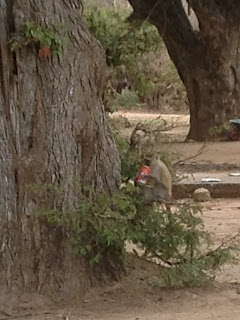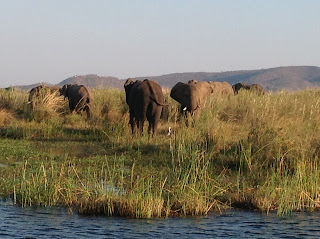
We chased monkeys away from our cabbage. We drove the car around warthog. We were awoken by hippos. We backed away from baboons. I chased monkeys away from our watermelon. I wrestled a monkey for a kabob. My afternoon was dictated by a curious elephant. Our dinners were interrupted every night by hippos. Our s'mores were stalled by a curious genet. I timidly watched the crocs in the river in front of our cabin. I was shocked to find a tree frog on my coffee cup. We rushed away from our campfire five seconds before an elephant walked up to it. I found this vervet monkey drinking a Fanta....
Chirundu is known as being
one of the wildest places in the country.
Our interactions with the wildlife along the Zambezi were fascinating,
fun, and -when I wasn't chasing them away from my dinner- as awe-inspiring as ever. Here
are some of the animals whose paths we crossed while relaxing in Chirundu…
Warthogs trot near the "road."
Monkeys, monkeys, everywhere!

Vervet monkeys wait to steal our food.










Elephants, elephants everywhere!

Tons of birds, all difficult to photograph! Here a large heron sits at the water's edge.
Two fish eagles chat in the trees as they watch the river.

Crocodiles, crocodiles everywhere!

Here a genet keeps us company for a few hours just after twilight. If you don't know about this rare, crazy cat/mongoose relative, look them up! The eyeballs of Teddy Ruxpin, head of a ferret, body of a leopard, tail of raccoon. This guy sits twenty feet from us for hours, creepily curious.


Hippos lounge in the Zambezi waters until twilight...

when they munch grass and interrupt our dinners.

The night time pics are terrible, but you've never experienced the dark until you've been in Africa at night!
This is a giant elephant next to our campfire, I swear.
Between the hippos and elephant, we got about twelve complete seconds of time next to the campfire! This picture was taken about ten seconds before a bull elephant came lumbering through.
Nightime in Africa may be dark, but it's never quiet. Animals crawl, shuffle, snort, roar, and bang all through the night. Sweet dreams, humans!








































